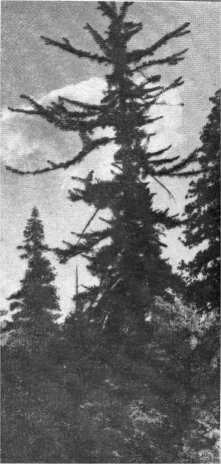
[click to enlarge]
| Online Library: | Title | Author | California | Geology | History | Indians | Muir | Mountaineering | Nature | Management |
Yosemite > Library > Cone-bearing Trees > Sugar Pine >
Next: Western White Pine • Contents • Previous: Jeffrey Pine
Pinus lambertiana Dougl.

[click to enlarge] |
Most evergreen trees conform to a normal architectural pattern so precisely that often from one spot thousands can be seen which appear to be cast from the same mold. Sugar Pines also have a generalized form, but deviate sufficiently from the standard so that no two are alike. Completely disregarding the conventional spire-like forms of their associates, Sugar Pines toss out horizontally from the massive trunks a few, huge, irregularly-shaped, and lengthened branches. These outspread arms, most often near the tops, growing apparently at the expense of nearby short branches and extending for thirty or even forty feet, produce on full-grown trees such wide, flattish-topped crowns that their identity is unmistakable from near or far. Sugar Pines once recognized and appreciated are never forgotten.
Along the Wawona Road between the Tunnel and Chinquapin, or along the new road to Crane Flat, the full-rounded colossal trunks of Sugar Pines, free of branches for heights frequently in excess of one hundred feet, command the attention of all who pass. And rightly so, for these richly colored, purplish-brown trunks attain the greatest diameters of any pines. Mature specimens will average six to eight feet in thickness and occasional trees are found of much greater diameter. The largest known Sugar Pine in Yosemite is ten feet in diameter at breast height. A fine monarch, eight feet through, grows on the bank of the Merced River between the Ahwahnee grounds and the second bridge on the main highway to Mirror Lake. This is one of four large trees of this species on the floor of Yosemite Valley.
It is well worth while to stop and wander amongst these kingly trees for they form the few remaining virgin Sugar Pine forests of the world. Through the timely action of public-spirited citizens and the Federal Government, large virgin stands of Sugar Pines have been recently added to the park, thus saving from sure destruction by the axe of the woodsmen the world’s few Sugar Pine stands of any consequence.
In addition to the form of the tree these pines may be also recognized by the enormous cones that hang in clusters at the very tips of the upper branches. When opened they average fourteen to eighteen inches long with a maximum length of twenty-four inches and are from four to six inches in diameter. They are so ornamental and prominent, that when present no other identification device is necessary. Although occasionally Sugar Pines and Western White Pines are confused because of the similarity of their immature cones, these two species can always be distinguished from one another if it is remembered that the unripened cones of the Western White Pines are curved and much shorter than those of the Sugar Pine. Also, the bark of the Western White Pine is broken into small rectangular plates, whereas the bark of the Sugar Pine is deeply fissured into long, narrow ridges that weather apart into irregularly shaped scales similar to those found on Western Yellow Pines.
Small Sugar Pines, too young to bear cones, can be identified by the leaves. This tree belongs to the class known as white pines, bearing needles in bundles of fives. There is very little difference between the foliage of Sugar and Western White Pines as both are from two to three and one-half inches long, slender and bluish-green in color. They can be identified as small trees with certainty only by knowing that Sugar Fines seldom range above 7500 feet elevation while Western White Pines rarely descend below 8000 feet.
Most admirers of trees agree with Dr. Jepson when he states that “the Sugar Pine is undoubtedly the most remarkable of all the pines, viewed either from the standpoint of its economic value or sylvan interest. It is the largest of the pine trees, considered either as to height or girth, and more than any other tree gives beauty and distinction to the Sierran forest.”
Next: Western White Pine • Contents • Previous: Jeffrey Pine
| Online Library: | Title | Author | California | Geology | History | Indians | Muir | Mountaineering | Nature | Management |
http://www.yosemite.ca.us/library/cone-bearing_trees/sugar_pine.html